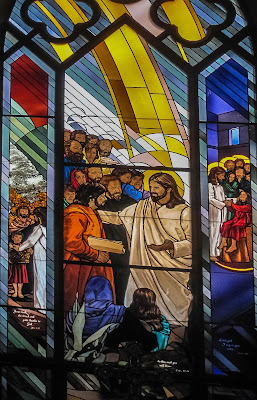New Hampshire was organized as an English royal colony in 1691 by William and Mary, the monarchs of England and Scotland. It was named after the county of Hampshire, in southern England, by Captain John Mason, the first proprietor. It was the first colony to establish a government independent of Great Britain, in January 1776, and the first to establish its own state constitution. It was one of the original 13 states that founded the United States of America and was the ninth state to ratify the U.S. Constitution, to bring it into effect, in June 1788.
In September 2011 we were driving by Concord, New Hampshire, along the freeway, and caught the gleaming gold dome of the State House, punctuated by the sun, and had to make a quick exit to visit. The State House, which is the capitol building, was built between 1816 and 1819.
 |
| New Hampshire State House in Concord. |
Across the street was a striking looking church, St. Paul's Episcopal Church, which we were drawn to.
 |
| St. Paul's in the background. |
As you can imagine, following the Revolutionary War, the Episcopal Church, because of its ties to the Church of England, was somewhat suspect. There were only four Episcopal churches in all of New Hampshire as of 1812. In 1818, ten men in Concord established St. Thomas's Chapel, an Episcopal church, which used the Masonic lodge as a meeting site. In the 1820s they built a wood church and then in about 1826 built a Gothic style church on the present site on Centre Street, right across the street from the new State House. In 1984 a fire started by an arsonist gutted the inside of the church, destroying all of the stained glass windows and leaving only the outer shell. The church was rebuilt with new stained glass made by a local artist.
 |
| I love this angel which reminds me of an adolescent shooting a pea shooter with wings much too small to sustain flight, thus the hop. |
 |
| The stained glass was quite different than much of the stained glass we see. Much more of a modern feel. |
When we visited, despite the history dripping from the granite walls of the State House and the statues of famous Americans on the grounds, we enjoyed the very small town atmosphere and freedom to go in and out of the capitol and the church across the street.











These are some of my favorite stained glass windows. While not as intricate as far as piecing goes, the painting on the glass is wonderful, and like you, I love the modern feel. I also enjoy the unusual choices of subject matter.
ReplyDeleteI love the pea-shootin' angel, and all of that stained glass has a joyful, exited fell.
ReplyDelete